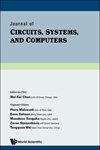利用FinFET技术提高稳健性和低功耗SRAM单元的稳定性
IF 1
4区 工程技术
Q4 COMPUTER SCIENCE, HARDWARE & ARCHITECTURE
引用次数: 0
摘要
在当前的纳米尺度下,翅片场效应晶体管(FinFET)技术克服了金属氧化物半导体场效应晶体管(MOSFET)技术的局限性。鲁棒和低功耗的静态随机存取存储器(SRAM)设计是存储器设计者的一项艰巨的任务,特别是在纳米尺度下。因此,本文提出了一种采用低功耗FinFET技术的基于10晶体管(10T)的SRAM单元设计。该方法不仅降低了漏电流,而且提高了电池在不同状态下的稳定性。采用多栅极预测技术模型(PTM)对功率为0.7 V的晶体管在10 nm技术节点上进行了模拟和分析。并与现有设计进行了对比分析。与传统的6T (C6T)设计相比,该SRAM单元的读写静态噪声边际和SRAM电量矩阵(SEQM)分别提高了3.54倍、1.71倍和26.41倍。采用蒙特卡罗模拟方法对所提出的SRAM单元的可靠性进行了研究和比较,其中[公式:见文本]%的工艺参数偏差。可靠性分析表明,该SRAM单元对工艺变化的敏感性较低。本文章由计算机程序翻译,如有差异,请以英文原文为准。
Improved Stability for Robust and Low-Power SRAM Cell using FinFET Technology
In the current nanoscale regime, fin field effect transistor (FinFET) technology overcomes the limitations of metal oxide semiconductor field effect transistor (MOSFET) technology. Robust and low-power static random access memory (SRAM) design is a demanding task for memory designers, especially in the nanoscale regime. Therefore, this paper proposes a 10 transistor (10T)-based SRAM cell design using low-power FinFET technology. The proposed approach not only reduces the leakage current, but also improves cell stability in different states. The proposed SRAM cell is simulated and analyzed at a 10[Formula: see text]nm technology node using a multi-gate predictive technology model (PTM) for the transistors with a power supply of 0.7[Formula: see text]V. The comparison analysis is also presented with the existing designs. The read and write static noise margins, and SRAM electrical quantity matrix (SEQM) of the proposed SRAM cell are improved by 3.54×, 1.71× and 26.41×, respectively, compared with the conventional 6T (C6T) design. The reliability investigations and comparison of the proposed SRAM cell have been carried out using Monte Carlo simulations with [Formula: see text]% deviations in the process parameters. The reliability analysis shows that the proposed SRAM cell is less sensitive to process variations.
求助全文
通过发布文献求助,成功后即可免费获取论文全文。
去求助
来源期刊

Journal of Circuits Systems and Computers
工程技术-工程:电子与电气
CiteScore
2.80
自引率
26.70%
发文量
350
审稿时长
5.4 months
期刊介绍:
Journal of Circuits, Systems, and Computers covers a wide scope, ranging from mathematical foundations to practical engineering design in the general areas of circuits, systems, and computers with focus on their circuit aspects. Although primary emphasis will be on research papers, survey, expository and tutorial papers are also welcome. The journal consists of two sections:
Papers - Contributions in this section may be of a research or tutorial nature. Research papers must be original and must not duplicate descriptions or derivations available elsewhere. The author should limit paper length whenever this can be done without impairing quality.
Letters - This section provides a vehicle for speedy publication of new results and information of current interest in circuits, systems, and computers. Focus will be directed to practical design- and applications-oriented contributions, but publication in this section will not be restricted to this material. These letters are to concentrate on reporting the results obtained, their significance and the conclusions, while including only the minimum of supporting details required to understand the contribution. Publication of a manuscript in this manner does not preclude a later publication with a fully developed version.
 求助内容:
求助内容: 应助结果提醒方式:
应助结果提醒方式:


